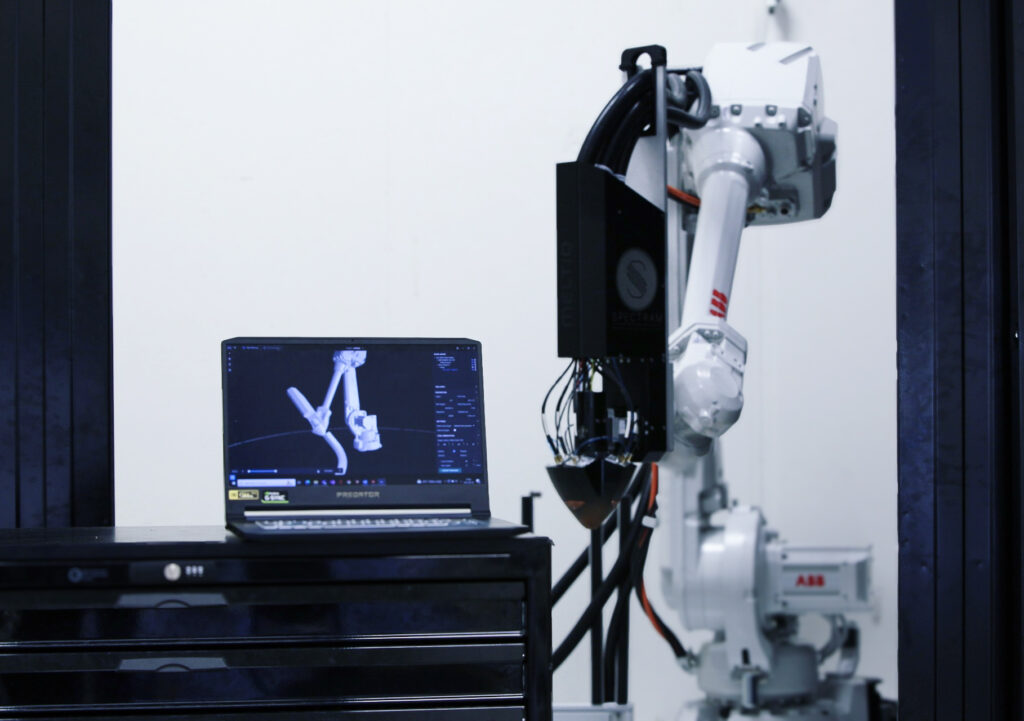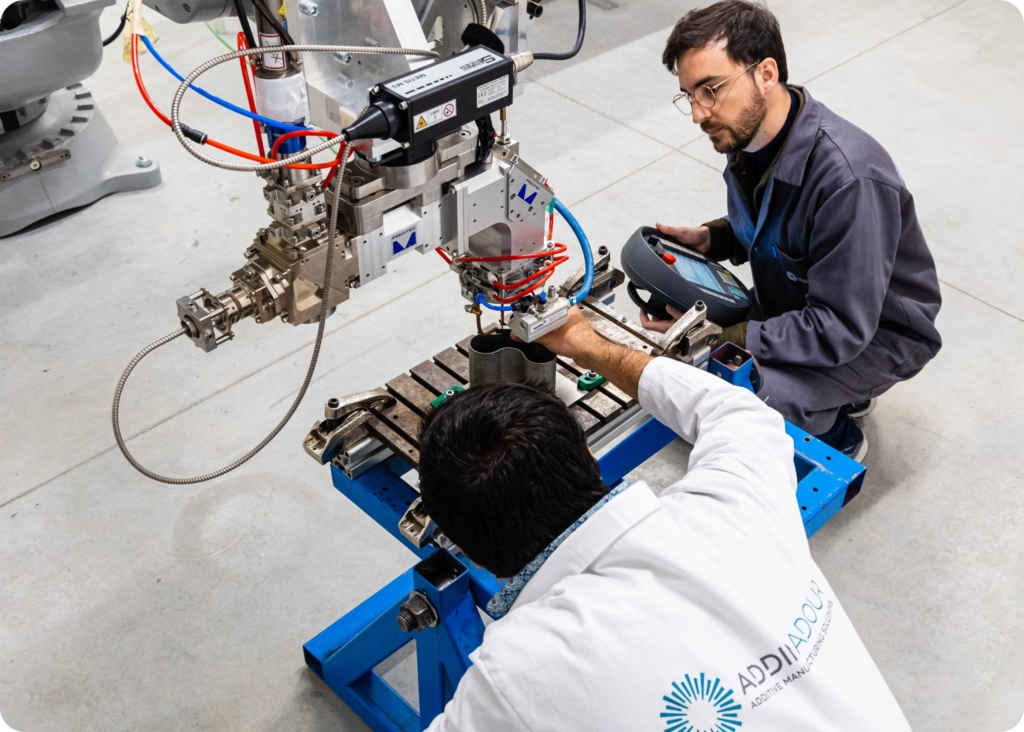Taking its advanced solutions outside of its European home, ADAXIS launched its U.S. headquarters in March 2024, setting the stage for a transformative fusion of robotics and 3D printing technologies in the American market. This development comes on the heels of ADAXIS’ software platform AdaOne, which transforms robotic arms into large-scale 3D printers. AdaOne streamlines the programming process for industrial robots, fostering the creation of sustainable and innovative products across various industries.
Founded in 2021, this French-Swedish robotics software startup is led by CEO and engineer Henri Bernard, who, along with co-founders Guénolé Bras, Emil Johansson, and Vasan Churchill, embarked on a mission to reinvent the manufacturing landscape. Their shared vision stemmed from a collaborative research project at France’s ESTIA (Higher School of Advanced Industrial Technologies) and RISE (Research Institutes of Sweden), where they encountered the time-consuming and complex task of programming industrial robots for 3D printing.
It was during this collaborative effort that the team realized the huge potential of combining industrial robotics with additive manufacturing (AM). This insight fueled the development of AdaOne, ADAXIS’ flagship software platform, which has since gained recognition for its intuitive interface and powerful capabilities.
In a recent interview with Bernard and ADAXIS’ North America Applications Manager, Justin Ferguson, they shed light on the company’s vision and the importance of its U.S. branch. Above all, Bernard emphasized a commitment to empowering industries with cutting-edge technology.
“With ADAXIS and AdaOne, we are trying to make manufacturing processes and robots accessible for users. By building access, we are pushing to make 3D printing with robots fun, cool, and accessible. We are really passionate about our software and have been fortunate enough to start quite early on our deployment to the United States,” says Ferguson. “The U.S. presents a dynamic landscape ripe for technological advancements in manufacturing. With ADAXIS USA Inc., we aim to not only address industry challenges but also drive transformative change,” reflected Ferguson.
Simplified Robotics
ADAXIS has simplified user experiences through its AdaOne software platform, making it easier for industries to adopt advanced manufacturing methods. Bernard and his co-founders identified the challenges at the intersection of robotics and AM, mainly due to the intricate nature of both technologies. It’s challenging for regular users to understand and operate these systems effectively, says Bernard. However, these challenges drive ADAXIS onward, making advanced manufacturing accessible to an even wider audience.
It’s a terribly niche sector, after all. Within the 3D printing software industry, ADAXIS stands pretty much on its own. The company specializes in robotics and additive, a space without much overlap with other software. AdaOne’s streamlined slicing, programming, and simulation is quite unique in its scope and approach.
Noting that there aren’t many direct competitors to ADAXIS, Ferguson says one or two open-source software and one commercially available software could be considered similar to what ADAXIS offers with AdaOne, but not even close to what its proprietary software can do.
“With ADAXIS, customers can request specific features and improvements, which the company can prioritize and implement efficiently. This contrasts with open-source software, where development may depend on project timelines and community contributions,” says Ferguson. “ADAXIS’ unique mission to make its software accessible, easy to use, and tailored to industrial needs sets it apart from any other software solutions that may be more complex, expensive, or time-consuming to deploy and maintain.”
While dedicated platforms like ADAXIS are rare, there are companies offering related solutions, but none of them target exclusively the combined robotics and 3D printing niche. For example, RoboDK primarily focuses on simulation and offline programming for industrial robots, extending support to 3D printing applications involving robotic arms. Materialise, known for its 3D printing software, also provides tools for medical image processing and simulation, which can be integrated with robotics in healthcare. Also, Siemens PLM Software offers CAD/CAM/CAE solutions, crucial for additive manufacturing processes and integration with robotic systems. Others, like Ai Build‘s AiSync accelerates and automates the creation of even the most advanced multi-axis toolpaths, while Autodesk’s Fusion 360 includes generative design and CAM programming tools suitable for robotic systems in various manufacturing processes, including 3D printing.
Print Power
By transforming robotic arms into large-scale 3D printers, AdaOne streamlines the entire process, from path planning and process optimization to control, all within a single, intuitive platform. This seamless integration reduces costs, lead times, and material waste and unlocks unprecedented possibilities for creating large-scale, sustainable products across industries like automotive, aerospace, manufacturing, construction, and interior design.
ADAXIS is trusted by world-leading innovators such as spacecraft maker ArianeGroup, French-based rail transport equipment manufacturer Alstom, and energy sector tubular product provider Vallourec. Moreover, the company collaborates with industry giants in robotics, advanced manufacturing, and materials, from ABB, Kuka, and DMG Mori in the robotics realm to materials giants like Mitsubishi Chemical and UPM Biofore.
Bernard and Ferguson highlighted some applications where ADAXIS has made significant strides, particularly in the energy and oil and gas sectors. However, they point out how remarkable it is to hear from other customers using ADAXIS’ solutions daily or weekly in exciting applications like business-to-consumer (B2C) applications, such as surfboards and design furniture.
“While these applications may not always grab the spotlight, they form the backbone of industry and manufacturing, focusing on delivering tangible results and profitability,” explains Bernard.
In addition to partnerships with private industry leaders, ADAXIS works closely with research institutions and academia, like the French engineering school Centrale Nantes or Italy’s Politecnico Milano. Ferguson points out that research institutions usually experiment with various variables to drive innovation.
“Unlike industry partners focused on immediate results, research institutions often engage in trial and error to uncover new insights and knowledge, which they are more inclined to share openly,” explains Ferguson. “ADAXIS facilitates this process by enabling researchers to test individual variables systematically within their AdaOne software platform, fostering a collaborative environment where results and improvements can be shared and integrated seamlessly.”
Beyond Borders
Although ADAXIS is now expanding beyond Europe, its dedication to simplifying robotic programming and advancing AM remains at the forefront. The inauguration of ADAXIS’ U.S. branch is a strategic move, solidifying its commitment to driving technological advancements and fostering sustainable manufacturing practices on a global scale. With over 250 users worldwide, this team of 20 innovators is growing, continuing to push boundaries, and shaping the future of industrial robotics and additive manufacturing.
“ADAXIS aims to create a seamless experience where users can easily navigate from concept to execution, much like how a familiar computer mouse simplifies complex tasks. We’re here to empower users, ensuring they feel confident and in control, bridging the gap between what’s possible and what’s not, instantly and effortlessly,” concluded Bernard.
All images courtesy of Adaxis.
Subscribe to Our Email Newsletter
Stay up-to-date on all the latest news from the 3D printing industry and receive information and offers from third party vendors.
Print Services
Upload your 3D Models and get them printed quickly and efficiently.
You May Also Like
The Dental Additive Manufacturing Market Could Nearly Double by 2033, According to AM Research
According to an AM Research report from 2024, the medical device industry, specifically in dentistry, prosthetics, and audiology, is expected to see significant growth as these segments continue to benefit from...
Heating Up: 3D Systems’ Scott Green Discusses 3D Printing’s Potential in the Data Center Industry
The relentless rise of NVIDIA, the steadily increasing pledges of major private and public investments in national infrastructure projects around the world, and the general cultural obsession with AI have...
AM Research Webinar Explores Continuum’s Sustainable Metal Additive Manufacturing Powders
Metal additive manufacturing (AM) powder supplier Continuum Powders is working to develop solutions that empower industries to reduce waste and optimize their resources. An independent life cycle assessment (LCA) of...
3D Printed Footwear Startup Koobz Lands $7.2M in Seed Round
California-based Koobz is focused on reshoring the U.S. footwear supply chain with advanced manufacturing processes, including 3D printing. The startup just announced that it has added $6 million to its...



































